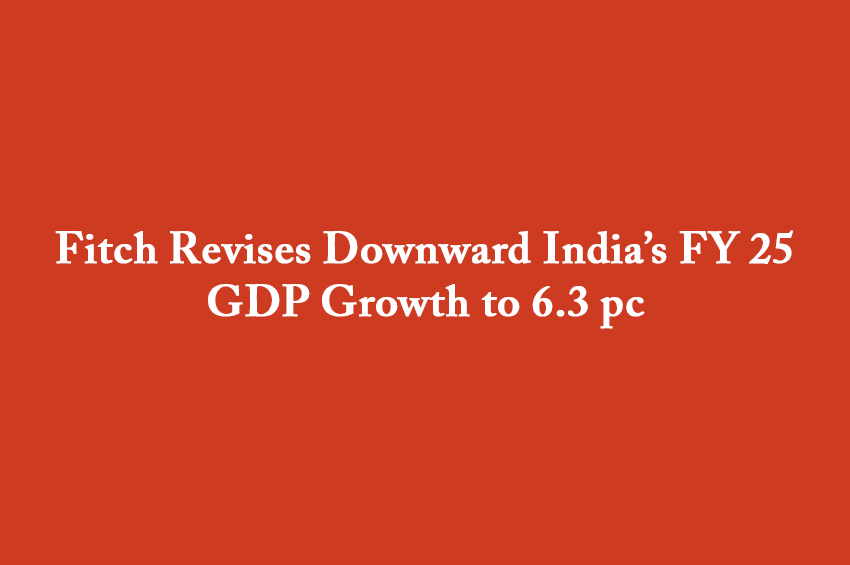Winning Bizness Economic Desk
Globally-renowned rating agency Fitch has pegged its GDP forecast for India for this fiscal (FY 25) at 6.3 per cent from 6.4 per cent. For the next fiscal (FY 26), Fitch has kept its growth projection unchanged at 6.5 per cent.
The ratings agency has also revised its FY 27 growth projection upward to 6.3 per cent from its earlier number of 6.2 per cent.
While more aggressive-than-expected US trade policies pose a significant risk to these forecasts, it believes India is somewhat insulated due to its low reliance on external demand.
In its latest Global Economic Outlook report, Fitch said that business confidence remains high in India as lending surveys pointed to continued double-digit growth in bank lending to the private sector.
According to Fitch, lower inflation would boost real incomes while the increased tax-free income allowances and revised tax brackets in the Budget would raise post-tax incomes.
Fitch predicts that food price dynamics in the coming months would enable a gradual decline in the headline inflation rate to 4 per cent by end-2025 and a mild increase to 4.3 per cent by December 2026.
Net Direct Tax Collections Up 13 pc till Mar 16
Net direct tax collections increased by a healthy 13.13 per cent to Rs 21.3-trillion as of March 16 of the current fiscal (FY 25). This was boosted by a vault in advance tax collections, according to the latest data from the Income Tax (IT) Department.
Advance tax collections so far in the current fiscal expanded by 14.6 per cent to Rs 10.4-trillion, up from the Rs 9.11-trillion of the previous year.
The fourth instalment of advance tax payment was due on March 15. Of net direct tax collections, non-corporate tax which include taxes paid by individuals, Hindu Undivided Families (HUFs), firms, bodies of individuals, association of persons, local authorities and artificial judicial persons—grew at a robust 17.5 per cent Year-on-Year (YoY) to Rs 11.01-trillion.
The corporate tax, during the same period, moved northward at a slower pace of 7.1 per cent to Rs 9.69-trillion. The Securities Tax Transaction (STT) rose 55.5 per cent to Rs 53,095-crore.
Gross direct tax collections during the period grew 16.15 per cent to Rs 25.9-trillion while refunds increased 32.5 per cent to Rs 4.6-trillion.
In advance tax collections, while corporate tax expanded 12.5 per cent to Rs 7.6-trillion, non-corporate tax was up 20.5 per cent to Rs 2.9-trillion, according to the data.
The government is targeting a total gross tax revenue of Rs 38.53-trillion (revised estimates) for FY 25. This includes a goal of Rs 22.37-trillion from direct taxes and Rs 16.16-trillion from indirect taxes.
In FY 2023-24, the Centre’s net direct tax revenue was Rs 19.6-trillion after accounting for refunds, reflecting a growth rate of 17.7 per cent.
Tata Steel Appoints Three Wales Contractors for Green Steel-Making Project
Blue-chip Tata group company, Tata Steel, has appointed three South Wales contractors to deliver key parts of its 1.25-billion Pound cutting-edge green steel-making project at Port Talbot.
Over 300 skilled jobs in the local supply-chain will be a part of new contracts signed with Brigend-based companies Darlow Lloyd and Sons, Wernick Buildings and Swansea-based Andrew Scott Ltd.
Darlow Lloyd and Sons will play a key role in the initial phases of the project, overseeing excavation, re-cycling, infrastructure and drainage works essential to the site’s transition to Electric Arc Furnace (EAF) steel-making.
Critical infrastructure, including the construction of a new scrap yard to manage the in-flow of UK-sourced used steel as a feed-stock for the new Electric Arc Furnace will be completed by Andrew Scott Ltd.
Wernick Buildings will deliver the centrepiece of Port Talbot’s contractor village—an 8.500-sq.m. space spanning three buildings comprising of offices and welfare zones.
Ninety per cent of the workers it employs to build this will be from communities surrounding the steel works spanning Swansea, North Port Talbot and Cardiff.
Industry Minister Ms Sarah Jones said: “Today’s news is a major boost for communities in South Wales, delivering high-skilled opportunities for local people and will help Welsh steel-making to drive growth and attract further investment as a part of our Plan for Change.”
Rubber Board to Begin Geo-Mapping of Plantations in India
The Rubber Board has initiated action to implement certifying NR under Indian Sustainable Natural Rubber (iSNR) and for EUDR compliance.
Such action has been necessitated because natural rubber and its derivatives are EU-listed commodities for deforestation-free regulations.
Mr M Vasanthagesan, Executive Director of the Rubber Board, inaugurated the EUDR sensitisation programme for representatives from rubber plantation companies in Kottayam, which will be followed by Thiruvananthapuram and Kozhikode.
To facilitate exports of rubber and rubber products to the EU, the Board has entrusted Trayambu Tech Solutions Pvt Ltd with supply-chain mapping and developing traceability systems as mandated in EUDR regulations.
The Board is rolling out 100 per cent polygon mapping of all the rubber plantations. The Board has initiated action to implement certification of natural rubber/rubber products under Indian Sustainable Natural Rubber (iSNR) for EUDR compliance and issue of a due diligence certificate.
As a part of compliance with EUDR regulations, supply-chain mapping development of traceability systems and geo-mapping of the plantations are pre-requisites for this process.
The Board will start geo-mapping large estates in Kerala, Tamil Nadu and Karnataka in a few days. This digital mapping effort will initially focus on these areas before expanding to other regions in the country.
The data collected will be stored in a centralised database hosted by the Board and confidentiality of the data will be ensured.
India’s Forex Reserves Rise by USD 305-mn to USD 654-bn
The country’s foreign exchange reserves registered an increase of USD 305-million to touch USD 654.271-billion in the week ending March 14, data from the Reserve Bank of India (RBI) showed.
This increase follows the previous week’s jump, which recorded the highest weekly gain in over three-years.
Before these recent increases, the forex reserves had been on steady slide for nearly four-months, hitting an 11-month low
The trend has since fluctuated, with alternate weeks of gains and declines.
Here, it must be pointed out that the country’s forex reserves had previously peaked at an all-time high of USD 704.89-billion in September, but they have since fallen by nearly seven per cent from that level.
The decline is largely attributed to the Reserve Bank of India (RBI)’s interventions aimed at curbing sharp depreciation of the Rupee, which remains near record lows against the US dollar.
The latest Reserve Bank data indicates that foreign currency assets (FCAs), the largest component of India’s forex reserves stood at USD 557.186-billion while gold reserves are valued at USD 74.391-billion.
According to estimates, the country’s current forex reserves are sufficient to cover approximately 10-11-months of projected imports, providing a buffer against external economic shocks.
India has added about USD 58-billion to its forex reserves in 2023, contrasting with a sharp cumulative decline of USD 71-billion in 2022.
In 2024, reserves registered a modest increase of just over USD 20-billion.


